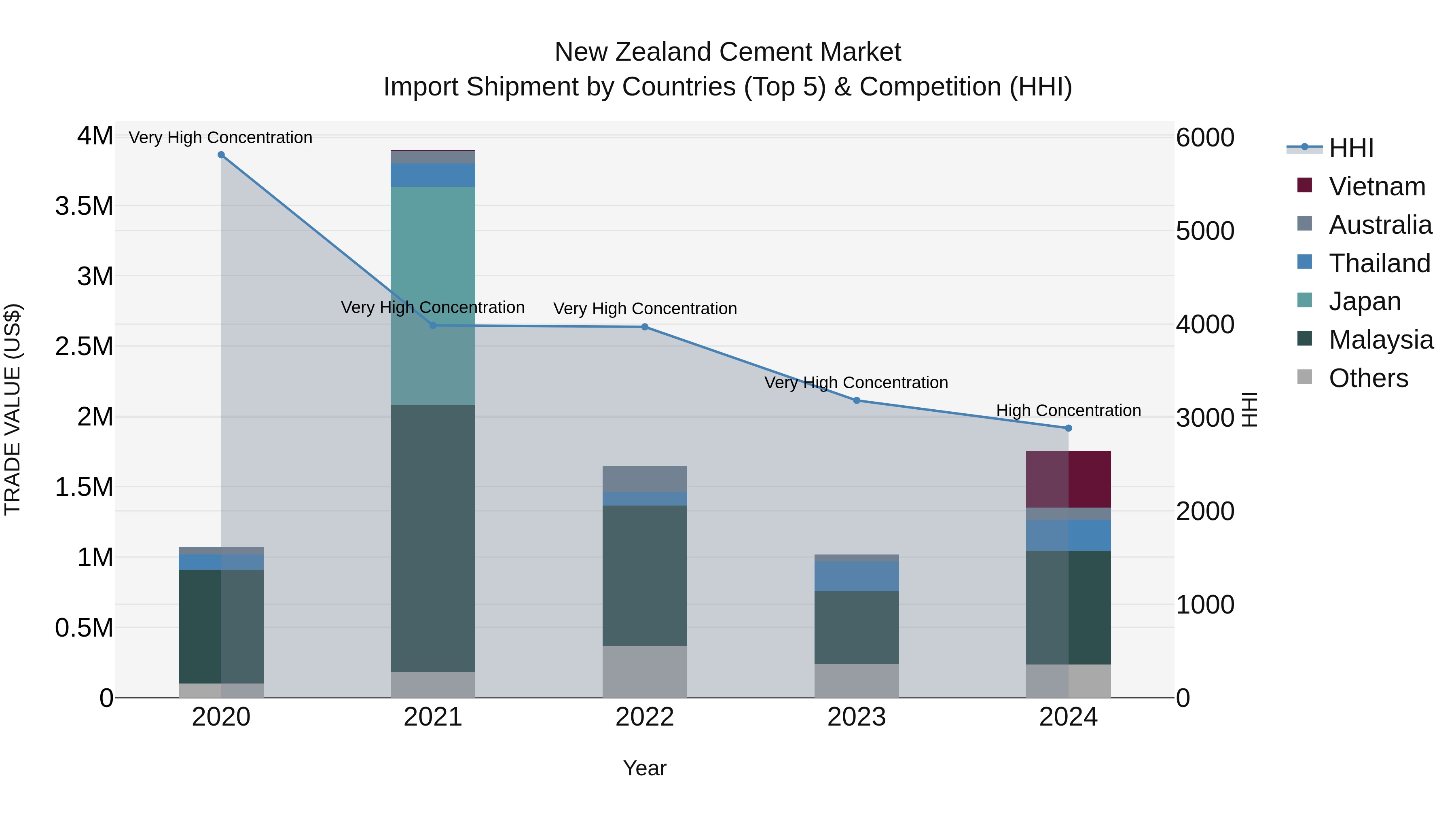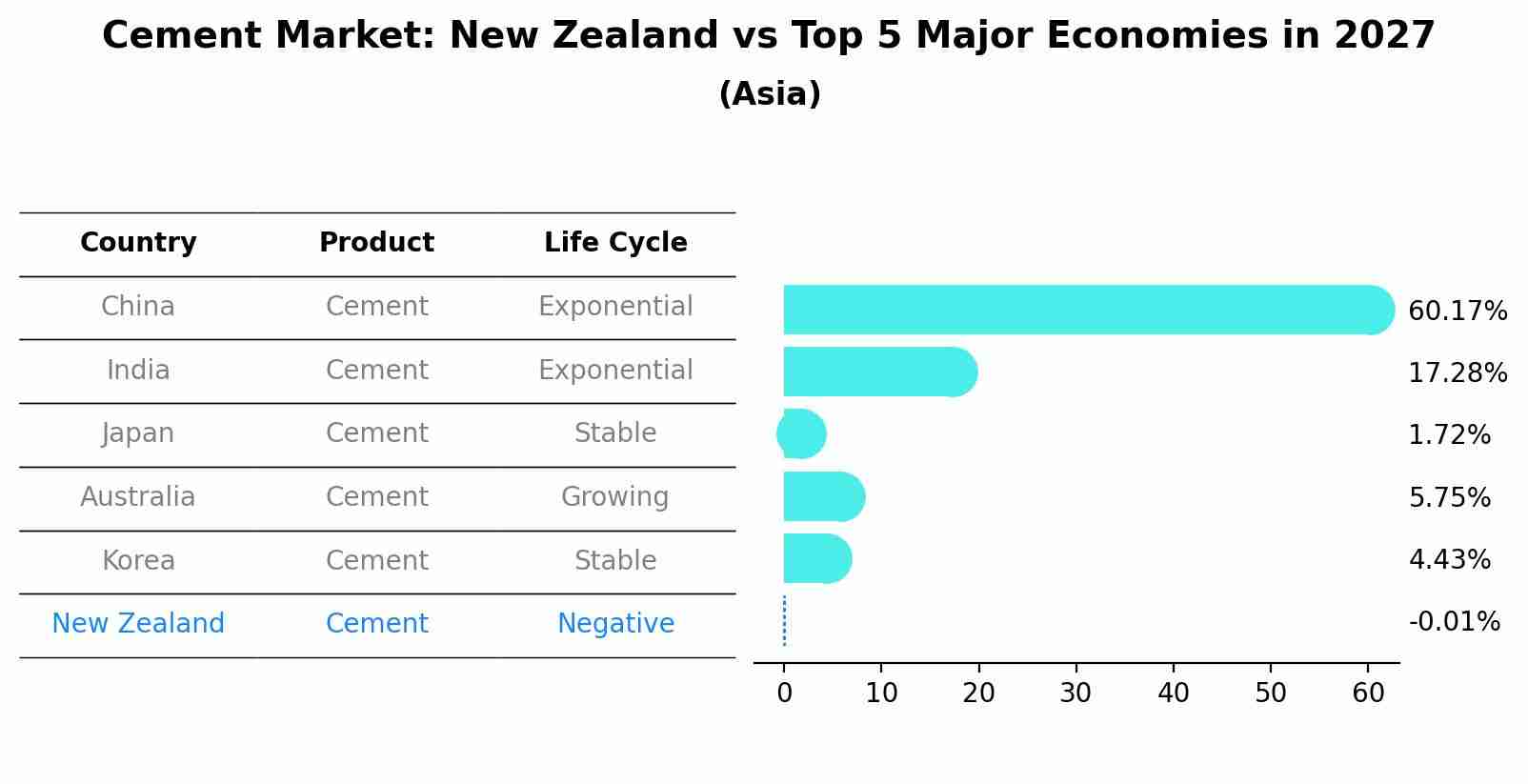New Zealand Cement Market (2025-2031) | Outlook, Companies, Revenue, Value, Segmentation, Trends, Growth, Industry, Share, Analysis, Size & Forecast
| Product Code: ETC5074959 | Publication Date: Nov 2023 | Updated Date: Nov 2025 | Product Type: Market Research Report | |
| Publisher: 6Wresearch | Author: Shubham Padhi | No. of Pages: 60 | No. of Figures: 30 | No. of Tables: 5 |
New Zealand Cement Market Top 5 Importing Countries and Market Competition (HHI) Analysis
The New Zealand cement import market continues to see significant growth, with a high concentration of shipments coming from Malaysia, Vietnam, Thailand, Australia, and Singapore in 2024. The market has experienced a notable increase in concentration levels, indicating a competitive landscape among the top exporting countries. The impressive CAGR of 13.06% from 2020 to 2024 highlights the sustained demand for cement imports. Moreover, the remarkable growth rate of 72.22% from 2023 to 2024 underscores the rapid expansion of the market, presenting opportunities and challenges for stakeholders in the industry.

Cement Market: New Zealand vs Top 5 Major Economies in 2027 (Asia)
By 2027, the Cement market in New Zealand is anticipated to reach a growth rate of -0.01%, as part of an increasingly competitive Asia region, where China remains at the forefront, supported by India, Japan, Australia and South Korea, driving innovations and market adoption across sectors.

Key Highlights of the Report:
- New Zealand Cement Market Outlook
- Market Size of New Zealand Cement Market, 2024
- Forecast of New Zealand Cement Market, 2031
- Historical Data and Forecast of New Zealand Cement Revenues & Volume for the Period 2021-2031
- New Zealand Cement Market Trend Evolution
- New Zealand Cement Market Drivers and Challenges
- New Zealand Cement Price Trends
- New Zealand Cement Porter`s Five Forces
- New Zealand Cement Industry Life Cycle
- Historical Data and Forecast of New Zealand Cement Market Revenues & Volume By Product for the Period 2021-2031
- Historical Data and Forecast of New Zealand Cement Market Revenues & Volume By Portland for the Period 2021-2031
- Historical Data and Forecast of New Zealand Cement Market Revenues & Volume By Others for the Period 2021-2031
- Historical Data and Forecast of New Zealand Cement Market Revenues & Volume By Application for the Period 2021-2031
- Historical Data and Forecast of New Zealand Cement Market Revenues & Volume By Residential for the Period 2021-2031
- Historical Data and Forecast of New Zealand Cement Market Revenues & Volume By Non-residential/Infrastructure for the Period 2021-2031
- New Zealand Cement Import Export Trade Statistics
- Market Opportunity Assessment By Product
- Market Opportunity Assessment By Application
- New Zealand Cement Top Companies Market Share
- New Zealand Cement Competitive Benchmarking By Technical and Operational Parameters
- New Zealand Cement Company Profiles
- New Zealand Cement Key Strategic Recommendations
Frequently Asked Questions About the Market Study (FAQs):
1 Executive Summary |
2 Introduction |
2.1 Key Highlights of the Report |
2.2 Report Description |
2.3 Market Scope & Segmentation |
2.4 Research Methodology |
2.5 Assumptions |
3 New Zealand Cement Market Overview |
3.1 New Zealand Country Macro Economic Indicators |
3.2 New Zealand Cement Market Revenues & Volume, 2021 & 2031F |
3.3 New Zealand Cement Market - Industry Life Cycle |
3.4 New Zealand Cement Market - Porter's Five Forces |
3.5 New Zealand Cement Market Revenues & Volume Share, By Product? , 2021 & 2031F |
3.6 New Zealand Cement Market Revenues & Volume Share, By Application? , 2021 & 2031F |
4 New Zealand Cement Market Dynamics |
4.1 Impact Analysis |
4.2 Market Drivers |
4.2.1 Growth in construction activities and infrastructure development in New Zealand |
4.2.2 Increasing government investments in public infrastructure projects |
4.2.3 Rise in urbanization and population growth leading to higher demand for residential and commercial buildings |
4.3 Market Restraints |
4.3.1 Fluctuating raw material prices impacting production costs |
4.3.2 Environmental concerns and regulations related to CO2 emissions from cement production |
4.3.3 Competition from alternative building materials such as steel and wood |
5 New Zealand Cement Market Trends |
6 New Zealand Cement Market Segmentations |
6.1 New Zealand Cement Market, By Product? |
6.1.1 Overview and Analysis |
6.1.2 New Zealand Cement Market Revenues & Volume, By Portland, 2021-2031F |
6.1.3 New Zealand Cement Market Revenues & Volume, By Others, 2021-2031F |
6.2 New Zealand Cement Market, By Application? |
6.2.1 Overview and Analysis |
6.2.2 New Zealand Cement Market Revenues & Volume, By Residential, 2021-2031F |
6.2.3 New Zealand Cement Market Revenues & Volume, By Non-residential/Infrastructure, 2021-2031F |
7 New Zealand Cement Market Import-Export Trade Statistics |
7.1 New Zealand Cement Market Export to Major Countries |
7.2 New Zealand Cement Market Imports from Major Countries |
8 New Zealand Cement Market Key Performance Indicators |
8.1 Energy efficiency improvements in cement production processes |
8.2 Adoption of sustainable practices in cement manufacturing |
8.3 Investment in research and development for innovative cement products |
8.4 Increase in demand for green building certifications for construction projects |
8.5 Compliance with environmental regulations and reduction in carbon footprint |
9 New Zealand Cement Market - Opportunity Assessment |
9.1 New Zealand Cement Market Opportunity Assessment, By Product? , 2021 & 2031F |
9.2 New Zealand Cement Market Opportunity Assessment, By Application? , 2021 & 2031F |
10 New Zealand Cement Market - Competitive Landscape |
10.1 New Zealand Cement Market Revenue Share, By Companies, 2024 |
10.2 New Zealand Cement Market Competitive Benchmarking, By Operating and Technical Parameters |
11 Company Profiles |
12 Recommendations | 13 Disclaimer |
- Single User License$ 1,995
- Department License$ 2,400
- Site License$ 3,120
- Global License$ 3,795
Search
Thought Leadership and Analyst Meet
Our Clients
Related Reports
- Australia Briquette Market (2025-2031) | Growth, Size, Revenue, Forecast, Analysis, Trends, Value, Share, Industry & Companies
- Vietnam System Integrator Market (2025-2031) | Size, Companies, Analysis, Industry, Value, Forecast, Growth, Trends, Revenue & Share
- ASEAN and Thailand Brain Health Supplements Market (2025-2031) | Strategy, Consumer Insights, Analysis, Investment Trends, Opportunities, Growth, Size, Share, Industry, Revenue, Segments, Value, Segmentation, Supply, Forecast, Restraints, Outlook, Competition, Drivers, Trends, Demand, Pricing Analysis, Competitive, Strategic Insights, Companies, Challenges
- ASEAN Bearings Market (2025-2031) | Strategy, Consumer Insights, Analysis, Investment Trends, Opportunities, Growth, Size, Share, Industry, Revenue, Segments, Value, Segmentation, Supply, Forecast, Restraints, Outlook, Competition, Drivers, Trends, Demand, Pricing Analysis, Competitive, Strategic Insights, Companies, Challenges
- Europe Flooring Market (2025-2031) | Outlook, Share, Industry, Trends, Forecast, Companies, Revenue, Size, Analysis, Growth & Value
- Saudi Arabia Manlift Market (2025-2031) | Outlook, Size, Growth, Trends, Companies, Industry, Revenue, Value, Share, Forecast & Analysis
- Uganda Excavator, Crane, and Wheel Loaders Market (2025-2031) | Strategy, Consumer Insights, Analysis, Investment Trends, Opportunities, Growth, Size, Share, Industry, Revenue, Segments, Value, Segmentation, Supply, Forecast, Restraints, Outlook, Competition, Drivers, Trends, Demand, Pricing Analysis, Competitive, Strategic Insights, Companies, Challenges
- Rwanda Excavator, Crane, and Wheel Loaders Market (2025-2031) | Strategy, Consumer Insights, Analysis, Investment Trends, Opportunities, Growth, Size, Share, Industry, Revenue, Segments, Value, Segmentation, Supply, Forecast, Restraints, Outlook, Competition, Drivers, Trends, Demand, Pricing Analysis, Competitive, Strategic Insights, Companies, Challenges
- Kenya Excavator, Crane, and Wheel Loaders Market (2025-2031) | Strategy, Consumer Insights, Analysis, Investment Trends, Opportunities, Growth, Size, Share, Industry, Revenue, Segments, Value, Segmentation, Supply, Forecast, Restraints, Outlook, Competition, Drivers, Trends, Demand, Pricing Analysis, Competitive, Strategic Insights, Companies, Challenges
- Angola Excavator, Crane, and Wheel Loaders Market (2025-2031) | Strategy, Consumer Insights, Analysis, Investment Trends, Opportunities, Growth, Size, Share, Industry, Revenue, Segments, Value, Segmentation, Supply, Forecast, Restraints, Outlook, Competition, Drivers, Trends, Demand, Pricing Analysis, Competitive, Strategic Insights, Companies, Challenges
Industry Events and Analyst Meet
Whitepaper
- Middle East & Africa Commercial Security Market Click here to view more.
- Middle East & Africa Fire Safety Systems & Equipment Market Click here to view more.
- GCC Drone Market Click here to view more.
- Middle East Lighting Fixture Market Click here to view more.
- GCC Physical & Perimeter Security Market Click here to view more.
6WResearch In News
- Doha a strategic location for EV manufacturing hub: IPA Qatar
- Demand for luxury TVs surging in the GCC, says Samsung
- Empowering Growth: The Thriving Journey of Bangladesh’s Cable Industry
- Demand for luxury TVs surging in the GCC, says Samsung
- Video call with a traditional healer? Once unthinkable, it’s now common in South Africa
- Intelligent Buildings To Smooth GCC’s Path To Net Zero


















